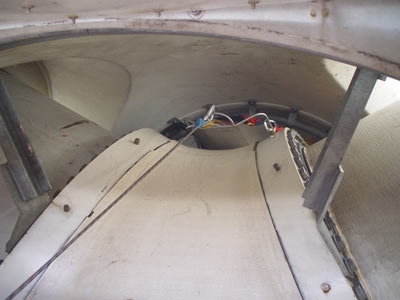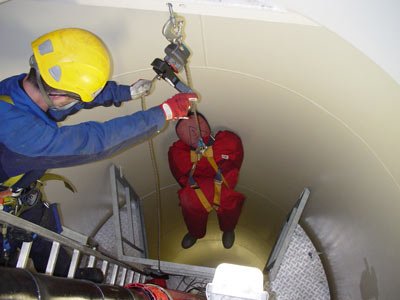Due to the unique nature of this work environment, suitable arrangements [2,3,4] need to be in place for the initial response, including the care and evacuation of any casualties, and liaison with external emergency services.
Emergency response should follow the pre-determined procedures detailed within the site’s emergency response plan (ERP). When developing one, consideration must be given to the remoteness of t he site location, response times and the equipment and training provided. Taking these measures not only promotes self-sufficiency but also helps to preserve life until emergency services arrive on site.
he site location, response times and the equipment and training provided. Taking these measures not only promotes self-sufficiency but also helps to preserve life until emergency services arrive on site.
In most cases, wind farms should have the necessary capabilities to respond to foreseeable situations, whether that is from the owner and/or operator, contractor(s) or other employer(s).
Every type of turbine, indeed perhaps every individual turbine, is different. Therefore, it’s vital that an ERP is practised and reviewed periodically. Any risk assessment also needs to take into account the prevailing weather conditions, the nature of any work being undertaken, the handling of loads, radio-frequency isolation, electrical issues, communications, safe access and egress, tools and equipment and the level of worker competence.
When it comes to planning for potential rescues, RenewableUK provides health and safety guidance for the wind energy sector. [5] The benchmark for work at height training and rescue is contained in an approved training standard. [6] Developed in consultation with the leading industry representatives, the aim of this standard is to ensure that all personnel are able to demonstrate a common level of basic competency.
The two-day course includes both basic and specific rescue principles and techniques, including techniques for the recovery of a casualty from a vertical ladder, nacelle and hub. The training also includes casualty handling techniques and the selection, inspection and use of equipment.
The emergency services’ ability to provide rescue from height has improved considerably since the publication of HSE’s Operational Circular 200/31. [7] Many are now able to provide advice on evacuation and rescue when planning rescue from height within wind turbines.
In terms of making arrangements for the rescue of personnel, wind turbine operators should include the selection of suitable rescue equipment, training of users, and bringing equipment to the required location.
Should a fire ever break out in the nacelle, escape would either be down the tower or, if the fire/smoke is located in the tower, by external descent. For offshore wind turbines, evacuation will be determined by a risk assessment of the site. This needs to take into account wind speed, whether it’s possible to land on the external platform, the sea temperature and potential time to rescue the person(s) from the water. [8]

Maintenance workers that repair the blades on the turbines will need a solid grasp of rope access techniques. With this in mind, it’s essential that rope access teams can attach to the system in a place of safety, that they prevent ropes from passing over sharp edges, and that they can access separate anchorages for working and back-up ropes. [9]
There is much to be gained from multi-agency exercises, to test the arrangements in place for the deployment of rescue equipment. It frequently leads to recommendations for the improvement of rescue planning and, in some instances, the installation of new equipment. Exercises also identify skills gaps, requiring an assessment of further specialist training or refreshers.
Offshore rescues are challenging, particularly those involving rescue from hub to nacelle, nacelle to transition piece, transition piece to vessel, vessel to vessel and, finally, vessel to shore. Depending on the location, this can take anything up to two hours.
References:
- www.renewableuk.com/en/renewable-energy/wind-energy/uk-wind-energy-database/index.cfm projects of 100 kW and larger (accessed 23 August 2014).
2. The Health and Safety at Work etc. Act 1974, sections 2 and 3.
3. Work at Height Regulations 2005, Reg. 4(2).
4. Management of Health and Safety at Work Regulations 1999, Reg. 3.
5. Guidelines for onshore and offshore wind farms, Health & Safety in the Wind Energy Industry Sector (RUK, 2010) (under review) and Offshore Wind and Marine Energy: Health and Safety Guidelines (RUK, 2014: Issue 2).
6. Working at Height & Rescue Training Standard (RUK, Issue 1: 2014) (aligned with GWO).
7. The Work at Height Regulations 2005 (Paras. 60 and 61) (HSE, 2006).
8. Offshore wind work at height guidance (Energy Institute/G9 Offshore Wind Health and Safety Association, 2014 – pending).
9. Application of IRATA International rope access methods for work on wind turbines (IRATA, August 2014).
David Thomas is technical director at The heightec Group Ltd


 he site location, response times and the equipment and training provided. Taking these measures not only promotes self-sufficiency but also helps to preserve life until emergency services arrive on site.
he site location, response times and the equipment and training provided. Taking these measures not only promotes self-sufficiency but also helps to preserve life until emergency services arrive on site.
